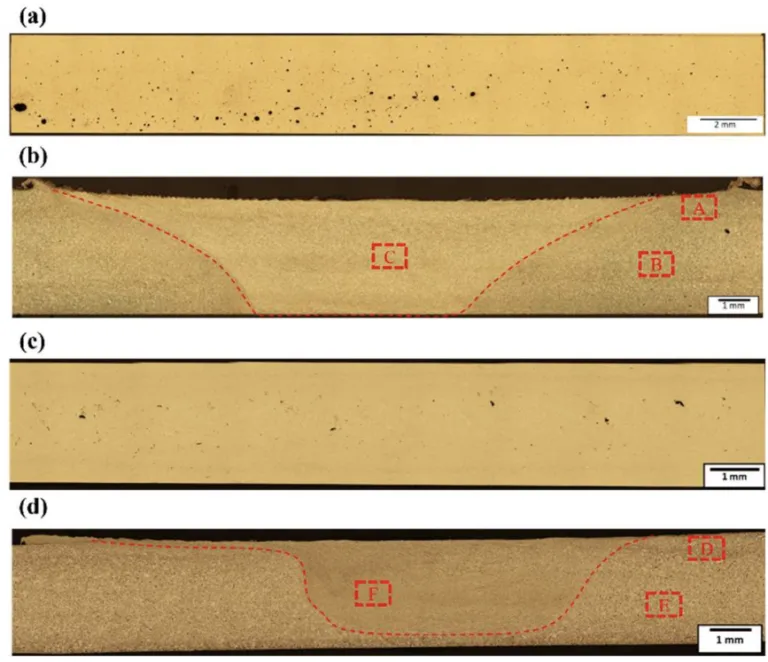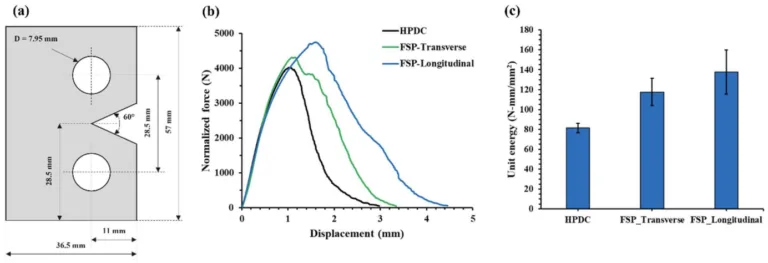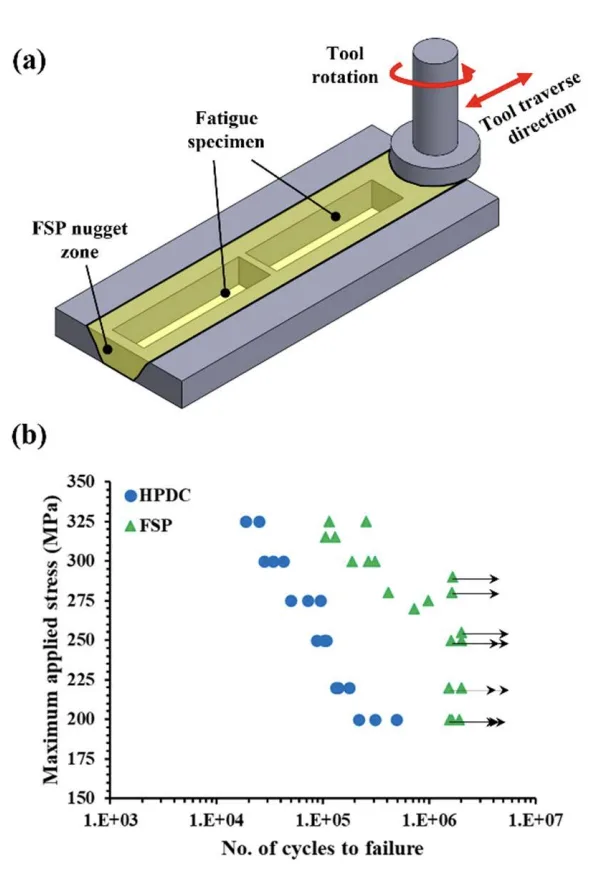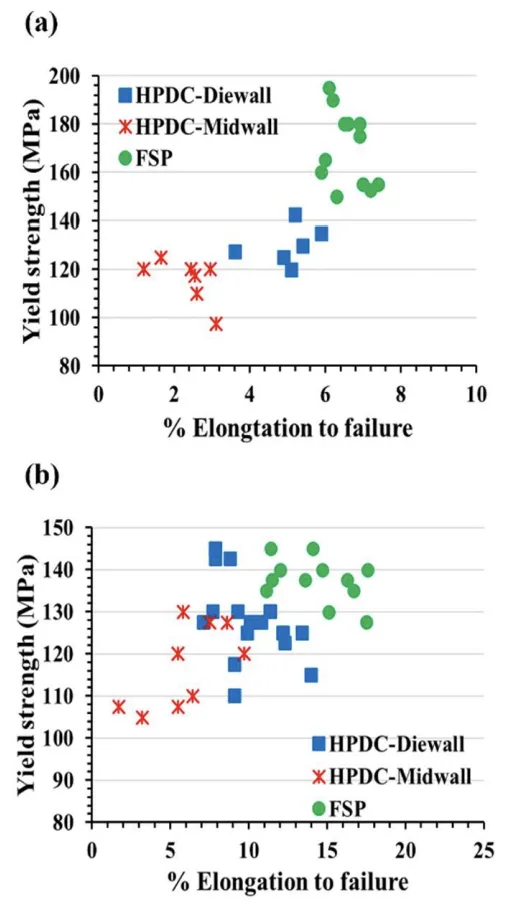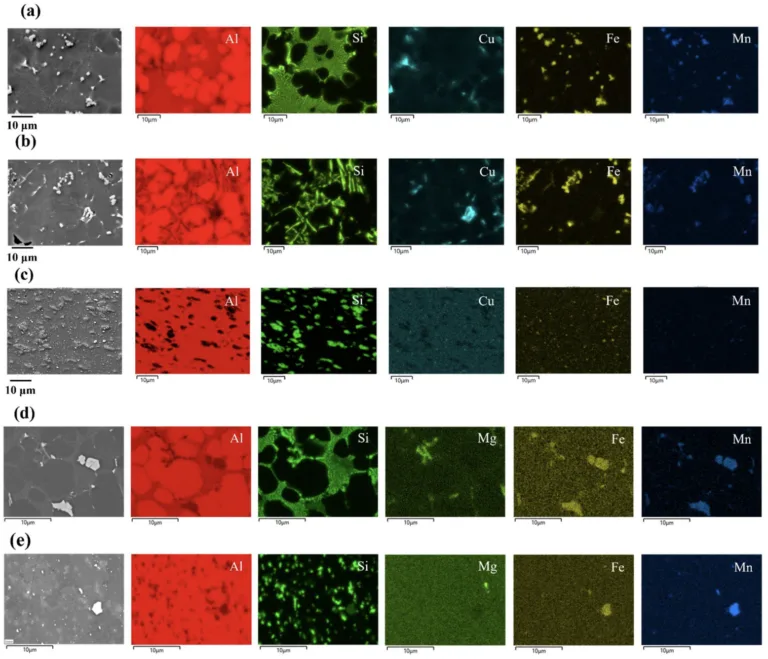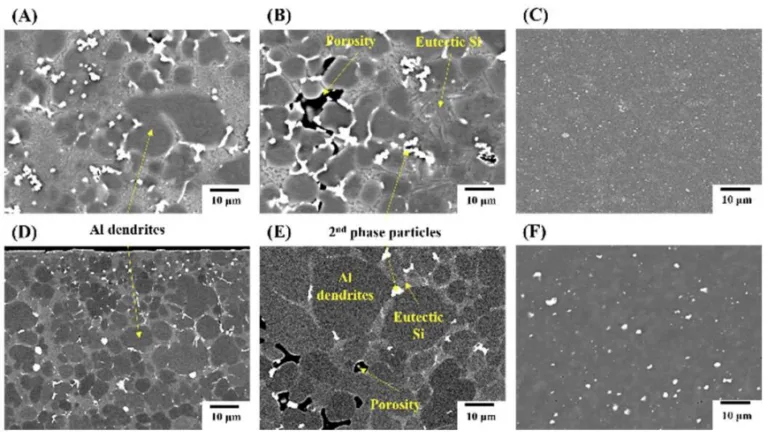この入門論文は、"Friction Stir Processing: A Thermomechanical Processing Tool for High Pressure Die Cast Al-Alloys for Vehicle Light-weighting"("[Manufacturing Letters]"発行)に基づいて作成されています。
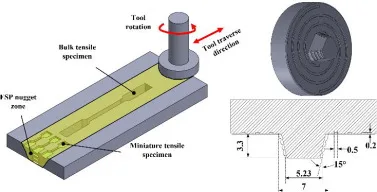
1. 概要:
- タイトル:摩擦攪拌処理:自動車軽量化のための高圧ダイカストアルミニウム合金の熱機械加工ツール
- 著者:Avik Samanta, Hrishikesh Das, Glenn J. Grant, Saumyadeep Jana
- 出版年:2024年
- 掲載ジャーナル/学会誌:Manufacturing Letters
- キーワード:摩擦攪拌処理、高圧ダイカスト、引張特性、疲労、引裂き靭性
2. 概要:
本研究では、高圧ダイカスト(HPDC)の熱機械加工に摩擦攪拌処理(FSP)を用い、組織を改質し、機械的特性を向上させることを目的とする。FSPは、薄肉フラットプレート形状の2種類のHPDCアルミニウム合金、すなわち(a)汎用、高鉄、HPDC A380合金と(b)プレミアム品質、低鉄HPDC Aural-5合金に対して実施された。その後の機械試験では、降伏強さと引張延性がそれぞれ約30%と約65%向上することが示された。さらに、FSPはA380合金の疲労寿命を約10倍、Aural-5合金の破壊靭性を約70%向上させた。これらの知見は、HPDC Al合金ベースの構造部品の組織を改質するFSPの能力を強調するものであり、長期的な耐久性と信頼性のために、強度、延性、破壊靭性、および高い疲労特性の良好な組み合わせを示すことができることを示唆している。
3. 導入:
ゼロカーボン排出への要求の高まりに応えるため、自動車OEM(相手先商標製品製造業者)は、重量のある構造用鋼アセンブリを軽量アルミニウム構造鋳物に置き換えることで、軽自動車(LD)の構造重量を低減するための低コストソリューションを模索している。高圧ダイカスト(HPDC)アルミニウム鋳物は、自動車設計におけるショックタワー、ピラー、フロアレールなどの重要な耐荷重ボディ構造において、OEMに設計、軽量化、品質の利点を提供する。HPDC Al鋳物を使用することで、複雑な構造プロファイル、高い耐久性、効果的な部品ユニット化を実現できる[1]。さらに、電気自動車技術が進歩するにつれて、ハイブリッドパワートレインと自動車の電化が自動車セクター内でますます重要になっている。軽量電気自動車の追求において、HPDCアルミニウム鋳物は、バッテリー用軽量エンクロージャーや、さまざまなパワートレインおよびトランスミッションコンポーネントの製造において重要な役割を果たすことができる。
Alダイカスト業界では、金型寿命の延長と最終鋳物の延性のバランスを取ることが常に課題である。この分野の研究は、両方の側面を改善し、低コストを維持するために材料化学を改質することを目的としたものが頻繁に行われている[2]。汎用ダイカストでは、高価な金型摩耗を低減するためにFeとMnが使用されるが、Fe濃度が高いと全体的な延性、ひいては疲労寿命が低下する。HPDC Al合金の化学組成には、溶融性、湯回り性、耐引裂き性を向上させるためにSiが添加される。さらに、HPDC合金を強化するためにCu、Zn、Mgが使用される。しかし、多元素組成のため、HPDC Al合金は、さまざまな金属間化合物を頻繁に生成する。頻繁に観察される2つの金属間化合物は、針状のβ-FeSiAl (FeSiAl5) と多面体のα-FeSiAl (Al15(MnFe)3Si2) である。中でもベータ相は、全体的な機械的特性、特に延性に関して有害な影響を及ぼす。HPDC Al合金には、針状シリコンとかなりの量の第二相粒子も含まれており、引張強度と延性に悪影響を及ぼす[3,4]。さらに、HPDC Al合金に固有のデンドライト組織は、鍛造組織と比較して機械的特性が低い。加えて、これらの合金はガスおよび収縮の気孔率を示し、機械的負荷下での応力集中と亀裂の発生部位となる。これらのHPDCプロセス関連および材料化学関連の有害な特徴が、車両構造部品としてのHPDC Al合金の用途を制限してきた[3]。
4. 研究の概要:
研究トピックの背景:
HPDCアルミニウム鋳物は、その利点にもかかわらず、固有の微細組織欠陥と材料化学的制約により、延性、疲労寿命、破壊靭性などの機械的特性が損なわれている。これらの制約は、自動車業界における軽量化と耐久性の要求の高まりという文脈において、車両構造部品へのより広範な応用を妨げている。
これまでの研究状況:
これまでの研究努力は、有害な特徴を軽減するために、合金化学とHPDCプロセスの改質に焦点が当てられてきた。真空アシストHPDCは、ガスおよび収縮気孔率を低減する。Silafont、Castasil、Auralなどのプレミアム低Fe HPDC Al合金は、有害なベータ相を排除することにより延性を向上させるために開発された。ストロンチウム(Sr)添加は、針状シリコンをより微細で繊維状の組織に改質するために使用され、強度と延性を向上させる。Sr改質合金であるAural-5は、構造用途で成功を収めている。しかし、収縮気孔率、デンドライト組織、せん断帯形成、外部凝固結晶(ESC)、第二相粒子など、課題は依然として残っている。
研究の目的:
本研究の目的は、薄肉HPDC Al合金の組織を改質し、機械的特性を向上させるための熱機械的後処理ツールとして、摩擦攪拌処理(FSP)を調査することである。このアプローチは、機械的性能の低下の原因となる微細組織欠陥と制約に直接対処することにより、コストのかかる合金組成とHPDCプロセス最適化の代替案を提供する。
コアとなる研究:
コアとなる研究は、2種類のHPDCアルミニウム合金、(i)高鉄A380と(ii)低鉄Aural-5の両方を薄肉フラットプレート形状でFSP処理することである。本研究では、FSPが組織の発達と、引張特性、疲労寿命、引裂き靭性などの機械的特性に及ぼす影響を評価する。機械的性能は、FSPが構造用途向けのHPDC Al合金の全体的な性能を向上させる効果を示すために、クーポンレベルの試験を通じて評価される。
5. 研究方法
研究デザイン:
本研究では、HPDC A380およびAural-5合金板のFSPを含む実験計画法を採用している。本研究では、処理された(FSP処理された)材料と未処理の(HPDC)材料の微細組織と機械的特性を比較する。2種類のHPDC Al合金を選択した。(i)高Fe含有A380および(ii)低Fe含有Aural-5。FSP試験は、フラットプレート形状(厚さ3.5 mmのA380および厚さ2.5 mmのAural-5)で実施された。
データ収集と分析方法:
- 微細組織特性評価: 光学顕微鏡(OM)と走査型電子顕微鏡(SEM)を用いて微細組織を観察した。ImageJソフトウェアを用いて、微細組織の特徴量、すなわち相の相当円直径(ECD)とアスペクト比を定量的に分析した。SEM-EDS分析を用いて元素マッピングを行った。
- 引張試験: 全厚サブサイズASTM E8試験片と小型引張試験片を用いて、引張特性(降伏強度(YS)、引張強度(UTS)、伸び率(%))を評価した。
- 疲労試験: 高サイクル曲げ疲労試験は、応力比R=0.1の4点曲げ構成で、全厚長方形試験片に対して実施した。
- 引裂き靭性試験: 従来の引裂き試験は、ASTM規格B871-01に従って、Vノッチ付き長方形試験片を用いて実施し、引裂き靭性を評価した。数値積分を用いて、荷重-変位曲線下の面積から単位全エネルギーを算出した。
研究トピックと範囲:
本研究は、以下に焦点を当てている。
- HPDC A380およびAural-5合金の微細組織改質に対するFSPの効果の調査。
- FSP後の引張特性(降伏強度、引張延性)の向上評価。
- FSPによるHPDC A380合金の疲労寿命の向上評価。
- FSPがHPDC Aural-5合金の引裂き靭性に及ぼす影響の判定。
- 異なる領域(ダイウォール対ミッドウォール)におけるFSP処理材と未処理HPDC材の機械的性能の比較。
6. 主な結果:
主な結果:
- 微細組織の進化: FSPは、A380合金とAural-5合金の両方において、鋳造気孔率を効果的に除去し、デンドライト組織を改質して、均一に分散した破砕されたシリコンと第二相粒子を有する鍛造組織に転換した。シリコン粒子と第二相粒子のサイズとアスペクト比は、FSP後に大幅に減少した。
- 引張特性の向上: FSPは、引張特性の大幅な向上をもたらした。降伏強度(YS)は、A380合金で約25%、Aural-5合金で約30%向上した。引張延性(%伸び)は、A380合金で約65%、Aural-5合金で約35%増加した。引張強度(UTS)は、ほぼ変化しなかった。
- 疲労寿命の向上: FSPは、曲げモードにおけるA380合金の高サイクル疲労寿命を大幅に向上させ、HPDC A380合金と比較して、高応力レベルで約5〜15倍、低応力レベルで15倍以上の向上を示した。
- 引裂き靭性の向上: FSPは、Aural-5合金の引裂き靭性を約70%向上させ、亀裂の発生と伝播に対する抵抗性の向上を示した。
図の名前リスト:
- Fig. 1. Schematic of FSP experimental setting with tool shoulder and pin geometry and position of miniature and bulk E8 tensile specimens with respect to FSP nugget zone.
- Fig. 2. Low-magnification microstructural overview of (a) HPDC A380; (b) FSPed A380; (c) HPDC Aural-5; (b) FSPed Aural-5.
- Fig. 3. Comparison of SEM microstructure of HPDC and FSPed material in locations (A) to (E) in Figure 2.
- Fig. 4. EDS Analysis of HPDC A380 alloy at (a) die-wall, (b) mid-wall, and (c) FSPed mid-wall, and HPDC Aural-5 alloy at (d) mid-wall and (e) FSPed mid-wall.
- Fig. 5. Comparison of engineering stress vs. percent elongation of bulk tensile specimen.
- Fig. 6. Combination of yield strength and % elongation to failure for HPDC and FSPed (a) A380 alloy and (b) Aural-5 alloy
- Fig. 7. Fatigue life improvement of HPDC A380 alloy after FSP: (a) location of fatigue specimen with the nugget zone, and (b) comparison of no. of cycles to failure for different stress levels
- Fig. 8. Tear toughness test for Aural-5: (a) Sample geometry; and Comparison of (b) the force-displacement curve and (c) unit total energy.
7. 結論:
本研究は、摩擦攪拌処理(FSP)が、合金化学(高Fe A380および低Fe Aural-5)に関係なく、HPDCアルミニウム合金の機械的特性を向上させるための熱機械的ツールとして効果的であることを実証した。FSP駆動の微細組織改質は、引張延性(A380で〜65%、Aural-5で〜35%)と降伏強度(A380で〜25%、Aural-5で〜30%)の向上につながった。A380の高サイクル疲労寿命(〜5倍から>15倍)およびAural-5の引裂き靭性(〜70%)にも大きな改善が見られた。機械的特性の向上は、気孔率などの鋳造欠陥の除去と、デンドライト組織を、破砕され均一に分散した相を有する均質な鍛造組織に改質したことによるものである。
8. 参考文献:
- [1] COSMO International. Aluminum High Pressure Die Casting. 2014.
- [2] Sigworth GK, Donahue RJ. The Metallurgy of Aluminum Alloys for Structural High-Pressure Die Castings. International Journal of Metalcasting 2021;15:1031-46. https://doi.org/10.1007/s40962-020-00535-х.
- [3] Hartlieb M. Aluminum alloys for structural die casting. Die Casting Engineer, 2013, p. 40-3.
- [4] Outmani I, Fouilland-Paille L, Isselin J, el Mansori M. Effect of Si, Cu and processing parameters on Al-Si-Cu HPDC castings. J Mater Process Technol 2017;249:559-69. https://doi.org/10.1016/j.jmatprotec.2017.06.043.
- [5] Niu XP, Hu BH, Pinwill I, Li H. Vacuum assisted high pressure die casting of aluminium alloys. J Mater Process Technol 2000;105:119-27. https://doi.org/10.1016/S0924-0136(00)00545-8.
- [6] Rowe J, editor. Advanced Materials in Automotive Engineering. Woodhead Publishing; 2012.
- [7] Sigworth GK. The Modification of Al-Si Casting Alloys: Important Practical and Theoretical Aspects. International Journal of Metalcasting 2008;2:19-40. https://doi.org/10.1007/BF03355425.
- [8] Hegde S, Prabhu KN. Modification of eutectic silicon in Al-Si alloys. J Mater Sci 2008;43:3009-27. https://doi.org/10.1007/s10853-008-2505-5.
- [9] Timpel M, Wanderka N, Schlesiger R, Yamamoto T, Lazarev N, Isheim D, et al. The role of strontium in modifying aluminium-silicon alloys. Acta Mater 2012;60:3920-8. https://doi.org/10.1016/j.actamat.2012.03.031.
- [10] Shabestari SG, Keshavarz M, Hejazi MM. Effect of strontium on the kinetics of formation and segregation of intermetallic compounds in A380 aluminum alloy. J Alloys Compd 2009;477:892–9. https://doi.org/10.1016/j.jallcom.2008.11.037.
- [11] Ganesh MRS, Reghunath N, J.Levin M, Prasad A, Doondi S, Shankar K v. Strontium in Al-Si-Mg Alloy: A Review. Metals and Materials International 2022;28. https://doi.org/10.1007/s12540-021-01054-y.
- [12] Shih TS, Shih FS. Effects of silicon, magnesium and strontium content on the qualities of Al-Si-Mg alloys. International Journal of Cast Metals Research 1998;10:273-82. https://doi.org/10.1080/13640461.1998.11819243.
- [13] Beals R, Niu X, Brown Z. Development of Advanced Aluminum Alloy for Structural Castings. In: Eskin D, editor. Light Metals 2022, Cham: Springer International Publishing; 2022, p. 73–82. https://doi.org/10.1007/978-3-030-92529-1_10.
- [14] Beals R, Conklin J, Skszek T, Zaluzec M, Wagner D. Aluminum High Pressure Vacuum Die Casting Applications for the Multi Material Lightweight Vehicle Program (MMLV) Body Structure. In: Hyland M, editor. Light Metals 2015, Cham: Springer International Publishing; 2015, p. 215-21. https://doi.org/10.1007/978-3-319-48248-4_38.
- [15] Sharma SR, Ma ZY, Mishra RS. Effect of friction stir processing on fatigue behavior of A356 alloy. Scr Mater 2004;51:237-41. https://doi.org/10.1016/j.scriptamat.2004.04.014.
- [16] Tsai FY, Kao PW. Improvement of mechanical properties of a cast Al-Si base alloy by friction stir processing. Mater Lett 2012;80:40-2. https://doi.org/10.1016/j.matlet.2012.04.073.
- [17] Freeney TA, Mishra RS. Effect of friction stir processing on microstructure and mechanical properties of a cast-magnesium-rare earth alloy. Metall Mater Trans A Phys Metall Mater Sci 2010;41:73-84. https://doi.org/10.1007/s11661-009-0080-2.
- [18] Luo XC, Kang LM, Liu HL, Li ZJ, Liu YF, Zhang DT, et al. Enhancing mechanical properties of AZ61 magnesium alloy via friction stir processing: Effect of processing parameters. Materials Science and Engineering A 2020;797. https://doi.org/10.1016/j.msea.2020.139945.
- [19] Karthikeyan L, Senthilkumar VS, Balasubramanian V, Arul S. Analysis of first mode metal transfer in A413 cast aluminum alloy during friction stir processing. Mater Lett 2010;64:301-4. https://doi.org/10.1016/j.matlet.2009.10.068.
- [20] Sun N, Apelian D. Friction Stir Processing of Aluminum Cast Alloys for High Performance Applications. JOM 2011;63:44-50. https://doi.org/10.1007/s11837-011-0190-3.
- [21] Nakata K, Kim YG, Fujii H, Tsumura T, Komazaki T. Improvement of mechanical properties of aluminum die casting alloy by multi-pass friction stir processing. Materials Science and Engineering A 2006;437:274-80. https://doi.org/10.1016/j.msea.2006.07.150.
- [22] Samanta A, Seffens RJ, Das H, Guzman A, Roosendaal TJ, Garcia D, et al. Microstructure-refinement-driven enhanced tensile properties of high-pressure die-cast A380 alloy through friction stir processing. J Manuf Process 2022;78:352–62. https://doi.org/10.1016/j.jmapro.2022.04.027.
- [23] Santella ML, Engstrom T, Storjohann D, Pan TY. Effects of friction stir processing on mechanical properties of the cast aluminum alloys A319 and A356. Scr Mater 2005;53:201-6. https://doi.org/10.1016/j.scriptamat.2005.03.040.
- [24] Rao AG, Deshmukh VP, Prabhu N, Kashyap BP. Ductilizing of a brittle as-cast hypereutectic Al-Si alloy by friction stir processing. Mater Lett 2015;159:417-9. https://doi.org/10.1016/j.matlet.2015.07.006.
- [25] Ma ZY, Pilchak AL, Juhas MC, Williams JC. Microstructural refinement and property enhancement of cast light alloys via friction stir processing. Scr Mater 2008;58:361-6. https://doi.org/10.1016/j.scriptamat.2007.09.062.
- [26] Nelaturu P, Jana S, Mishra RS, Grant G, Carlson BE. Influence of friction stir processing on the room temperature fatigue cracking mechanisms of A356 aluminum alloy. Materials Science and Engineering A 2018;716:165-78. https://doi.org/10.1016/j.msea.2018.01.044.
- [27] Tajiri A, Uematsu Y, Kakiuchi T, Tozaki Y, Suzuki Y, Afrinaldi A. Effect of friction stir processing conditions on fatigue behavior and texture development in A356-T6 cast aluminum alloy. Int J Fatigue 2015;80:192–202. https://doi.org/10.1016/j.ijfatigue.2015.06.001.
- [28] Abubaker HM, Merah N, Al-Badour F, Sorour AA, Ul-Hamid A, Kumar AM, et al. Influence of Friction Stir Processing on Wear, Corrosion, and Fracture Toughness Behavior of 2507 Super Duplex Stainless Steel. J Mater Eng Perform 2021;30:89–102. https://doi.org/10.1007/s11665-020-05325-4.
- [29] Samanta A, Das H, Grant GJ, Jana S. Effect of tool design and pass strategy on defect elimination and uniform, enhanced tensile properties of friction stir processed high-pressure die-cast A380 alloy. Materials Science and Engineering: A 2022;861:144388. https://doi.org/10.1016/j.msea.2022.144388.
- [30] ASTM standard, Designation: B871-01, Standard Test Method for Tear Testing of Aluminum Alloy Products (Current edition approved April 1, 2007. Published May 2007. Originally approved in 1996. Last previous edition approved in 2001 as B 871-01). 2007.
- [31] Yang KV, Cáceres CH, Nagasekhar A v., Easton MA. The skin effect and the yielding behavior of cold chamber high pressure die cast Mg-Al alloys. Materials Science and Engineering A 2012;542:49-55. https://doi.org/10.1016/j.msea.2012.02.029.
- [32] Xia Y, Zheng J, Chen J, Zhang Y, Shi R, Zhou H, et al. The Ductility Variation of High-Pressure Die-Cast AE44 Alloy: The Role of Inhomogeneous Microstructure. Metall Mater Trans A Phys Metall Mater Sci 2021;52:2274-86. https://doi.org/10.1007/s11661-021-06220-w.
- [33] Bauchau OA, Craig JI. Euler-Bernoulli beam theory, 2009, p. 173-221. https://doi.org/10.1007/978-90-481-2516-6_5.
9. 著作権:
- This material is a paper by "Avik Samanta, Hrishikesh Das, Glenn J. Grant, Saumyadeep Jana". Based on "Friction Stir Processing: A Thermomechanical Processing Tool for High Pressure Die Cast Al-Alloys for Vehicle Light-weighting".
- Source of the paper: https://doi.org/10.1016/j.mfglett.2024.504512
この資料は上記の論文に基づいて要約されたものであり、商業目的での無断使用は禁止されています。
Copyright © 2025 CASTMAN. 無断複写・転載を禁じます。
